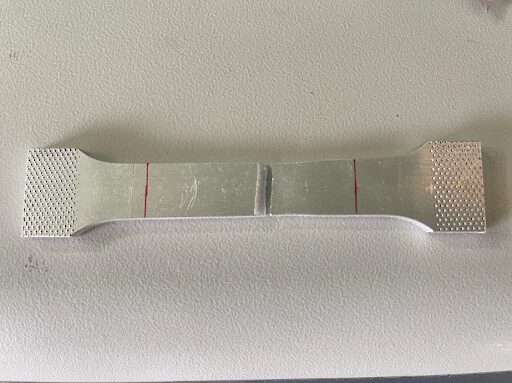How to Prepare a Tensile Coupon for Accurate Tensile Testing Results

Accurate tensile testing begins with properly prepared specimens. A tensile coupon—a precisely machined test piece—is critical for evaluating a material’s strength, ductility, and overall mechanical behavior. Whether you are testing metals, plastics, or composites, the shape, dimensions, and surface finish of the coupon directly affect test outcomes.
Improper specimen preparation is a leading cause of inconsistent results and failed audits. Standards such as ASTM E8/E8M and ISO 6892 exist to guide correct geometry and tolerances. Following these standards is not optional—it is necessary to obtain valid, repeatable data.
This article explains what tensile coupons are, why they matter, and how to prepare them step-by-step. Additionally, it includes a description of the equipment that is used to verify that the coupons are suitable for tensile testing.
Understanding Tensile Coupons and Their Importance
A tensile coupon is a standardized test specimen used to measure how a material behaves when pulled until it breaks. The data collected—such as ultimate tensile strength, yield strength, and elongation—helps manufacturers and engineers evaluate if a material meets mechanical requirements.
What sets a tensile specimen apart from a general test sample is its strict adherence to standard shapes and dimensions. For example, flat coupons typically include a reduced gauge section and wider gripping ends, while round samples may have threaded or shoulder ends. These features assure that the material fails in the gauge section—not in the grip.
Standards like ASTM E8 and ISO 6892 define specific shapes, lengths, and tolerances. If the coupon does not match these requirements, the results cannot be considered valid or comparable among tests.
Incorrectly prepared specimens can lead to:
Premature fracture outside the gauge area
Non-uniform stress distribution
Slippages during testing
Skewed elongation or strength readings
In addition, many industries—especially aerospace, automotive, and structural manufacturing—require proof of proper specimen preparation as part of their quality systems.
Simply put, without a properly prepared tensile coupon, even the most advanced tensile testing machine cannot deliver reliable results. That is why preparation is not just the first step—it is one of the most critical steps in the entire testing process.
Step-by-Step Guide to Preparing a Tensile Coupon
Preparing a tensile samples involves more than cutting material—it requires attention to standard geometry, surface condition, and dimensional accuracy. Below is a clear process followed in most quality-focused testing environments:
1. Select the Material Section
Start by choosing a sample that represents the bulk material. Avoid areas with visible defects, surface treatments, or edge damage. If possible, the material should be uniform and from a consistent batch.
2. Cut to Rough Dimensions
Use a bandsaw, abrasive cutter, or similar tool to cut the raw piece slightly larger than the final coupon dimensions. Avoid overheating, which can alter the material properties near the cutting edge.
3. Machine to Final Shape
Follow dimensions and tolerances defined by standards such as ASTM E8 (for metallic materials). Common shapes include flat “dogbones” or round specimens. Machining must be done precisely to avoid burrs, tapering, or irregular edges.
4. Verify Dimensions
Use calipers, micrometers, or optical measurement tools to confirm key parameters—width, thickness, gauge length, and transition radius. Any deviation may result in invalid test results or premature failure during tensile testing.
5. Inspect the Surface Finish
The gauge section must have a smooth, uniform finish. Rough or scratched surfaces can concentrate stress. Light grinding or polishing is often used to achieve the required finish, especially for smaller or brittle materials.
6. Store Properly Before Testing
Keep the prepared coupons free of contaminants, corrosion, or mechanical damage. Store them in clean containers or racks until testing begins.
Proper preparation is the foundation of trustworthy data. Even a well-calibrated testing system cannot compensate for poor specimen geometry or surface condition.
Essential Equipment for Tensile Coupon Preparation
Achieving consistency and precision in tensile specimen preparation requires the right tools. Below are the most commonly used types of tensile testing equipment and systems used throughout the specimen preparation process.
1. Tensile CNC Sample Preparation Machines
These machines are specifically designed to mill or turn tensile coupons to their exact dimensions based on pre-defined standards. CNC systems reduce variability and operator error. Models range from benchtop CNC lathes for round specimens to milling machines for flat samples.
2. Tensile Abrasive and Precision Cutting Equipment
To begin the preparation process, tensile sample cutting systems with controlled feed and coolant flow prevent material distortion. High-quality abrasive cutters provide clean cuts for metallic or composite materials.
- Grinding and polishing tools
For finishing the gauge section, surface grinders or polishing wheels are used to meet surface roughness requirements. Smooth gauge areas are especially important for accurate strain measurement.
4. Measurement and Verification Tools
Micrometers, digital calipers, and optical comparators are essential for verifying tensile coupon dimensions. Some tensile testing labs use laser measurement systems for extra precision, especially for thin or brittle specimens.
5. Fixturing and Alignment Tools
Holding jigs and alignment blocks help maintain accuracy during machining. Proper fixturing makes sure that each tensile sample is machined symmetrically and without vibration or deflection.
6. Support Tools for Traceability
Barcode scanners, label printers, and software tracking systems manage coupon data from preparation through testing. This traceability supports lab compliance and ISO/IEC 17025 documentation.
Investing in reliable tensile sample preparation equipment directly impacts your test results. Poorly cut or finished samples can compromise even the most effective tensile testing systems. By using modern, precise tools, labs can meet international standards and avoid costly rework or invalid tests.
Precision Starts Before the Test Begins
Reliable tensile testing does not begin when the machine starts—it begins with how the tensile coupon is prepared. Every detail, from material selection to surface finish, directly influences your results’ accuracy and repeatability. Improper preparation can lead to inconsistent data, failed audits, and costly retesting.
Following established standards like ASTM E8 or ISO 6892, verifying dimensions, and using appropriate techniques guarantees that each tensile coupon performs as expected under test conditions. Just as important is the use of proper tensile sample preparation equipment, including CNC machines, precision cutters, and accurate measurement tools.
Investing in preparation is investing in trust—trust in your data, your equipment, and your decisions. By treating tensile specimen preparation as a critical step, not a background task, manufacturers and laboratories can protect both their test results and reputations.

Source: How to Prepare a Tensile Coupon for Accurate Tensile Testing Results



